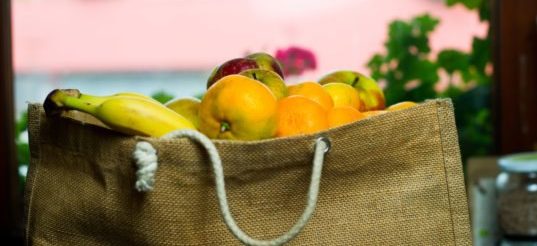Simple tips to reduce single-use plastic | Inhabitat – Green Design, Innovation, Architecture, Green Building

In recent years, it has become more and more clear that single-use plastics are having a devastating impact on the environment — especially on the oceans. And, if we don’t start making some changes now, it won’t be long before there is more plastic in the ocean than fish. The solution to this growing problem is relatively simple — reduce the use of single-use plastics. But, the execution of this simple idea can be a bit more challenging. If you want to make 2019 the year that you quit using single-use plastics, here is how to go about it.
Food and beverages
The easiest and most obvious place to start is food. Stop and think for a minute how many single-use plastics are in your refrigerator and pantry right now. Chances are you have a tub of butter, a bottle of salad dressing or a package of sliced cheese. Or maybe you have a bag of apples that you picked from the produce section at the grocery store.
The truth is, the vast majority of grocery items come wrapped in single-use plastic, but that doesn’t mean there aren’t other options.
There are local grocers and farmer’s markets that allow you to fill reusable containers with dry goods, and you can bring reusable bags to just about any store and load them up with fruits and veggies instead of using the plastic bags they provide.
Also, look for items that are packaged in paper, glass or cardboard instead of plastic. You won’t be able to do this with every food item — we haven’t seen any milk in glass bottles lately. But, often, you can find the things that you normally buy in sustainable packaging.
Now, let’s talk about beverages. This is a big one. How many to-go beverages do you buy in one week? From bottled water to iced coffees, millions of single-use plastic containers are tossed in the trash every single day because of what we drink.
Many coffee shops will allow you to bring in your own reusable tumbler. And, instead of buying that next bottle of water, opt for a reusable bottle that you can fill up with filtered water at home.

Household items
When it comes to things around your house like soap, shampoo, laundry detergent, cosmetics, razors and toothbrushes, they all come in single-use plastic containers.
Consider making your own soap, shampoo and laundry detergent, and replacing your plastic toothbrush with a bamboo, compostable option. Some cosmetics brands have a refill program, and razor refill companies are everywhere at the moment.

The benefits of change
When you start making a deliberate attempt to cut down single-use plastics, you will notice some big changes in your life.
The biggest change will be that you will eat fewer amounts of processed food. More than half of the average American’s daily diet comes from processed foods, and a lot of that is in single-use plastic packaging.
Not only will making this change reduce your use of plastic, but it will also result in a healthier diet.
You will also find yourself saving some money. When you make your own soap and detergent and cut down on buying bottled water, you will end up saving cash in the long run. Many coffee shops will give you a discount when you use a reusable mug, and making food from fresh ingredients instead of ordering takeout will be much easier on your pocketbook.
You will also become more organized because avoiding single-use plastic requires a plan. Adopting this lifestyle is not convenient, but when you make your own lunch for work instead of hitting a drive-thru or take a reusable bottle with you when you travel, you have to think ahead.
Another bonus to cutting out single-use plastic is shopping locally. Hitting up local businesses, farmer’s markets and vintage shops will lead you to get to know the people that make the products you use, instead of buying packaged items that come from all over the world.
You might consider growing your own produce in a veggie garden and experiment with fruits and veggies that are in season. Because you are focused on fresh food that isn’t wrapped in plastic, this new approach will make you more aware of the seasons and help you embrace the slow-food movement.
Reducing your use of single-use plastic items takes a plan, and it takes time. It is not a convenient lifestyle, but a rewarding one. Not only will you have a new understanding of the work and resources that go into growing and harvesting your food and making the products you use everyday, but you will also reduce your waste.
